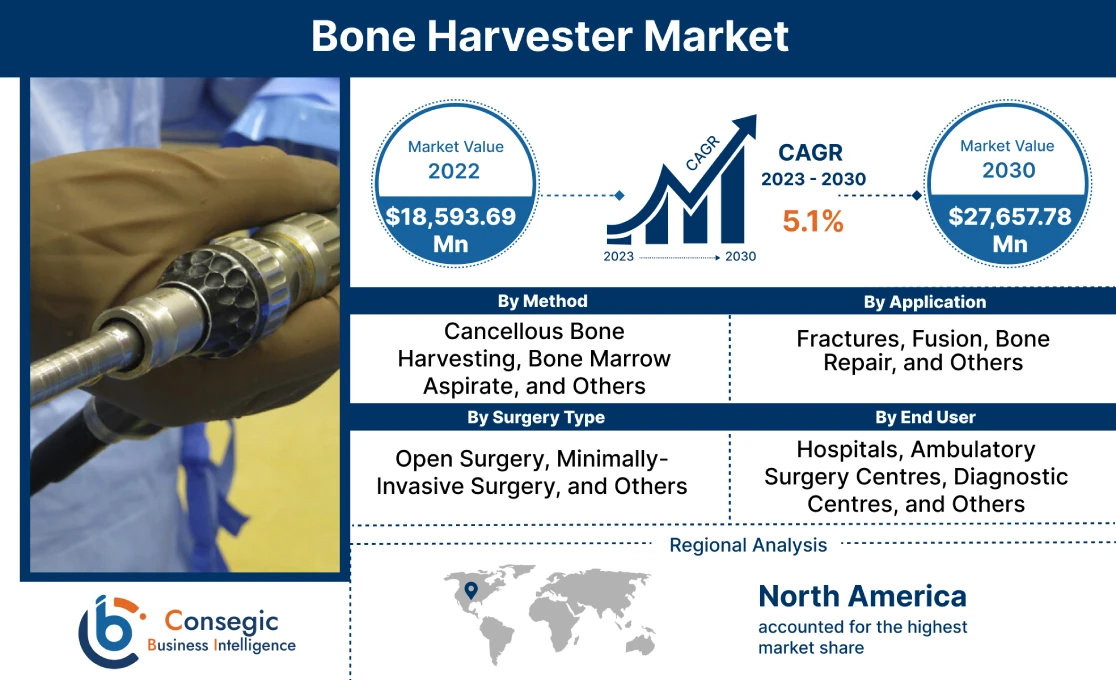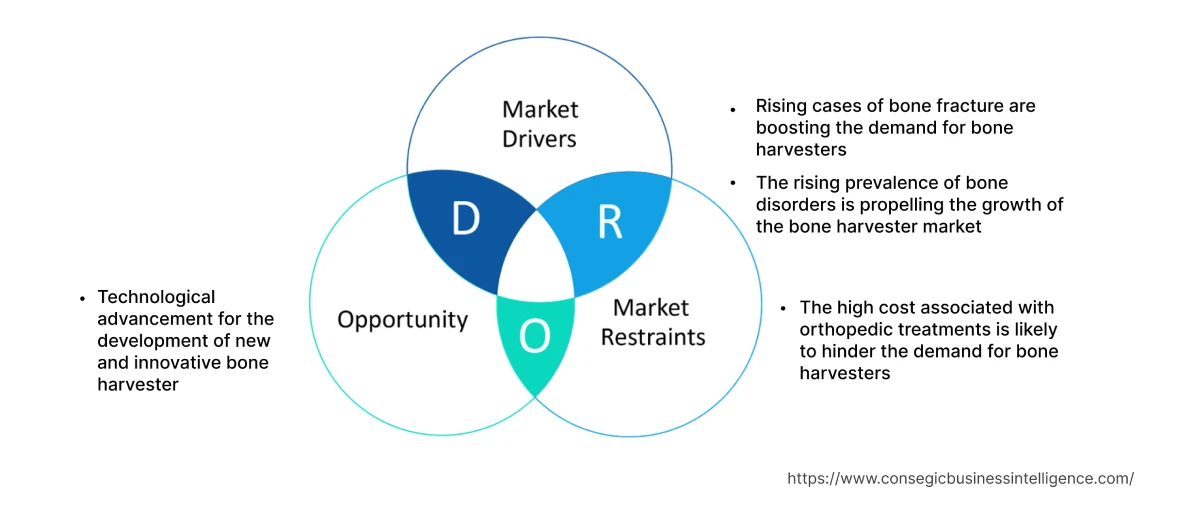Bone Harvester Market Size :
Consegic Business Intelligence analyzes that the Global Bone Harvester Market Size is growing with a CAGR of 5.1% during the forecast period (2023-2030), and the market is projected to be valued at 27,657.78 Million by 2030 from 18,593.69 Million in 2022.
Bone Harvester Market Scope & Overview :
The bone harvester typically consists of a handle and a hollow tube with sharp cutting edges that are used to efficiently obtain bone grafts from the patient's body. Such a type of graft provides structural support and enhances bone healing. The common types of bone grafting performed in hospitals include autograft, allograft, and synthetic bone grafting. A bone graft is a surgical procedure used to replace the damaged bones. Bone grafts are indicated for a range of orthopedic aberrations such as non-unions, delayed unions, comminuted fractures, bone disorders, and congenital diseases.
Bone Harvester Market Insights :
Key Drivers :
Rising cases of bone fracture
The increasing cases of bone fractures due to sports injuries, car accidents, and trauma injuries result in bone defects which drives the demand for bone harvesting. A bone harvester is a medical device used in orthopedic surgery to harvest bone grafts from a patient's body. Bone grafts are used as a filler and scaffold to facilitate bone formation and promote wound healing. These grafts are bioresorbable and act as a mineral reservoir that induces new bone formation by using a bone harvester.
For instance, according to the scientific report published by Springer Nature Limited in April 2022, a total of 67,249 patients were admitted to hospitals in China with 68,989 fractures. The highest proportion of fractures was in the tibia and fibula (14.9%), followed by the femur (13.6%) and ulna and radius (12.5%). Hence, the increasing cases of bone fractures due to accidents and trauma injuries are driving the need for bone grafting, which in turn resincrease of bone harvester market demand.
The rising prevalence of bone disorders
The increasing cases of bone disorders such as osteoporosis, arthritis, osteomalacia (rickets), and hyperparathyroidism are resulting in weakened bone, loss of bone, or delayed bone growth. Such type of bone disorders widely requires orthopedic surgeries. For instance, osteoporosis is a bone disease that develops when bone mineral density and bone mass decrease, or the structure and strength of bone change. Such a type of disorder requires bone grafting surgeries. Bone grafting is a surgical procedure that uses the transplanted bone to repair and rebuild diseased or damaged bone using a medical device known as a bone harvester. Analysis of bone harvester market trends showcases that the harvesters are used to obtain bone grafts efficiently for successful grafting surgeries.
For instance, according to the statistics published by the International Osteoporosis Foundation, 1 in 3 women over the age of 50 years and 1 in 5 men over the age of 50 years, worldwide, are suffering from osteoporosis. Hence, the increasing cases of bone disorders require the need for bone harvesting which is further contributing in increase of bone harvester market demand.
Key Restraints :
The high cost associated with orthopedic treatments
Orthopedic surgeries require bone harvesting systems that provide surgeons with an efficient way to recover autogenous bone from various harvest sites. Analysis of market trends indicates that the high costs associated with orthopedic surgeries, bone transplants, and the expensive devices that are required for bone grafting act as key factors in hampering the growth of the market. For instance, according to the statistics published by the National Library of Medicine, the most popular synthetic ceramics used in bone surgeries are Mastergraft and Vitoss which together, comprised more than half of the bone graft substitute market. In cases where synthetic grafts were used, surgeons applied an average of 12.7 mL of graft at an average price of approximately USD 1,100 per case. Hence, this high cost of synthetic grafts is likely to limit the market growth.
Future Opportunities :
Technological advancement for the development of new and innovative bone harvester
The advancement in technology provides opportunities to the key players for the manufacturing of advanced bone harvesters that are anticipated to obtain high-quality autografts and offer minimally invasive surgery to patients and are more efficient in terms of bone harvesting than standard devices. For instance, Avitus Orthopaedics, a medical device company, introduced the Avitus Bone Harvester - 6mm Edition. This device is an excellent option for surgeons to harvest small to large volumes of autologous bone graft and marrow from smaller bone anatomies such as the calcaneus and distal radius. The new harvester also features a 30% smaller pilot hole entry than the standard edition. Hence, the increasing development of advanced harvester devices is emerging as one of many bone harvester market opportunities leading to market expansion.
Bone Harvester Market Report Insights :
| Report Attributes | Report Details |
| Study Timeline | 2017-2030 |
| Market Size in 2030 | USD 27,657.78 Million |
| CAGR (2023-2030) | 5.1% |
| Based on the Method | Cancellous Bone Harvesting, Bone Marrow Aspirate, and Otherss |
| Based on the Application | Fractures, Fusion, Bone Repair, and Others |
| Based on the Surgery Type | Open Surgery, Minimally-Invasive Surgery, and Others |
| Based on the End User | Hospitals, Ambulatory Surgery Centres, Diagnostic Centres, and Others |
| Based on the Region | North America, Europe, Asia-Pacific, Latin America, and Middle East & Africa |
| Key Players | Acumed LLC, Globus Medical, Arthrex, Inc., Paragon 28, Inc., Conmed Corporation, Paradigm Biodevices Inc., Zimmer Biomet, DePuy Synthes (Johnson & Johnson), Avitus Orthopaedics, Trinity Orthopedics, Wright Medical Group N.V., Stryker, and Biogennix, LLC. |
Bone Harvester Market Segmental Analysis :
By Method :
The method segment is categorized into cancellous bone harvesting, bone marrow aspirate, and others. In 2022, the bone marrow aspirate segment accounted for the highest bone harvester market share of 43.50% in the overall market and is expected to grow at the fastest CAGR during the forecast period. In a bone marrow aspiration, a thin needle is used to remove a small amount of liquid bone marrow, usually from the pelvis. Assessment of market trends concludes that bone marrow aspiration ensures the bone marrow is healthy and produces a normal amount of blood cells. Such type of a method is used to diagnose several conditions including anemia, blood cell conditions, and blood cancer, among others. For instance, according to the statistics published by the National Cancer Institute, in 2020, an estimated 490,875 people were living with leukemia (blood cancer) in the U.S. Hence, this increasing prevalence of blood cancer is expected to proliferate the growth of bone marrow aspiration and marrow biopsy for diagnosis and monitoring of blood diseases.
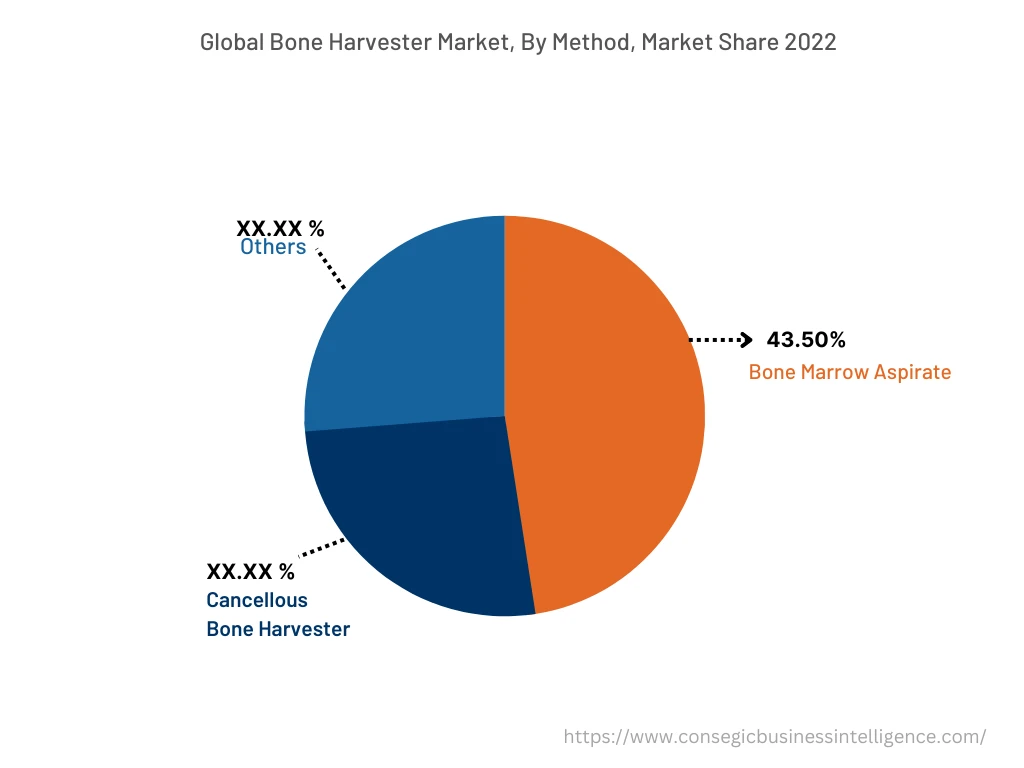
By Application :
The application segment is divided into fractures, fusion, bone repair, and others. In 2022, the bone repair segment accounted for the highest bone harvester market share. Osteoarthritis is a degenerative disease resulting in chronic pain. Osteoarthritis can degrade cartilage, cause inflammation, and change bone shape resulting in stiffness, pain, and loss of mobility. Such type of bone disorders results in bone repair. Analysis of market trends indicates that bone grafts are considered the gold standard for bone repair because they have excellent biocompatibility and potential for bone regeneration.
For instance, according to the Osteoarthritis (OA) Action Alliance, osteoarthritis (OA) is the most common form of arthritis, affecting 32.5 million adults in the U.S. and 62% of individuals with osteoarthritis are women. Hence, the rising cases of osteoarthritis are driving the need for bone repair which is further increasing the bone harvester market growth.
Analysis of market trends predicts that the bone fracture segment is expected to grow at the fastest CAGR over the forecast period. A bone fracture occurs due to the minimal trauma injury resulting from certain medical conditions that weaken the bones such as osteoporosis, osteopenia, osteopenia, and bone cancer. The rising prevalence of such bone disorders is expected to increase the demand for harvesters to perform efficient orthopedic surgery to repair and rebuild diseased or damaged bones.
By Surgery Type :
The surgery type segment is categorized into open surgery, minimally-invasive surgery, and others. In 2022, the open surgery segment accounted for the largest market share in the market. Open surgery requires a sufficient length of incision to allow the surgeon to place retractors and visualize the bone. Such type of surgery has a few disadvantages such as longer recovery time, lengthy incisions and retraction, and high complication rates.
Analysis of market trends predicts that the minimally invasive surgery segment is expected to grow at the fastest CAGR over the forecast period. Minimally invasive is a laparoscopic surgery that involves multiple small incisions to perform a surgical procedure. These smaller incisions offer benefits such as a lower risk of bleeding and decreased infection rates compared to open surgery. For instance, Trinity Orthopedics launched COREX a revolutionary, minimally invasive bone harvester made to simplify and streamline the harvesting process. Such types of devices allow for reduced operative time, efficient cancellous bone extraction, and zero infection rates which are the key factor expected to significantly boost the bone harvester market growth.
By End-User :
The end-user segment is classified into hospitals, ambulatory surgery centers, diagnostic centers, and others. In 2022, the hospital segment accounted for the highest market share and is also expected to grow at the fastest CAGR over the forecast period. This is due to the rising cases of accidents resulting in increasing bone fractures and the increasing prevalence of osteoporotic fractures among postmenopausal females. Such type of bone fractures requires brane grafting. A bone harvester is a medical device used to obtain bone grafts from a patient's own body. Analysis of market trends indicates that the rising adoption of advanced bone harvesters in hospitals for autogenous bone grafting is driving the market growth.s
For instance, according to the statistics published in the National Library of Medicine, the overall prevalence of osteoporotic fractures among postmenopausal females was 82.2% out of which 37.5% were osteoporosis and 44.7% were osteopenia. This increasing prevalence of bone fractures is driving the demand for bone harvesting or grafting, in turn, driving the growth of the market.
By Region :
The regional segment includes North America, Europe, Asia Pacific, the Middle East and Africa, and Latin America.
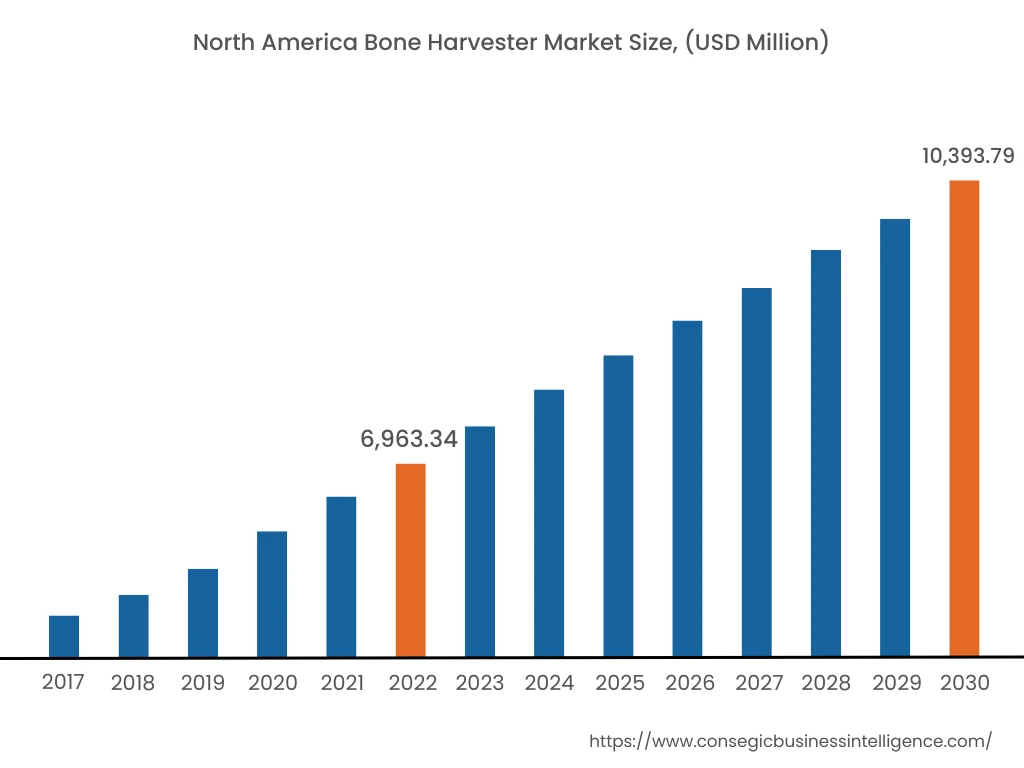
In 2022, North America accounted for the highest market share at 37.45% and was valued at USD 6,963.34 million, which is expected to reach USD 10,393.79 million in 2030. In North America, the bone harvester market analysis indicated that U.S. accounted for the highest market share of 65.35% during the base year 2022 owing to the increasing incidences of orthopedic disorders and surgeries in the U.S. Assessment of market trends indicates that the market players in the region are involved in mergers and acquisitions, product innovations, and business strategies to cater to the growing needs of various end-use industries by offering advanced medical devices. For instance, in November 2019, Wright Medical Group Inc., a global medical device company was acquired by Stryker Company. This acquisition is expected to offer advanced medical devices in the orthopedics segment.
Moreover, Asia Pacific is expected to grow at the fastest CAGR of 6.2% during the forecast period due to the growing government investment in the development of advanced medical devices, the rising patient population, and new hospital facilities particularly in China and India.
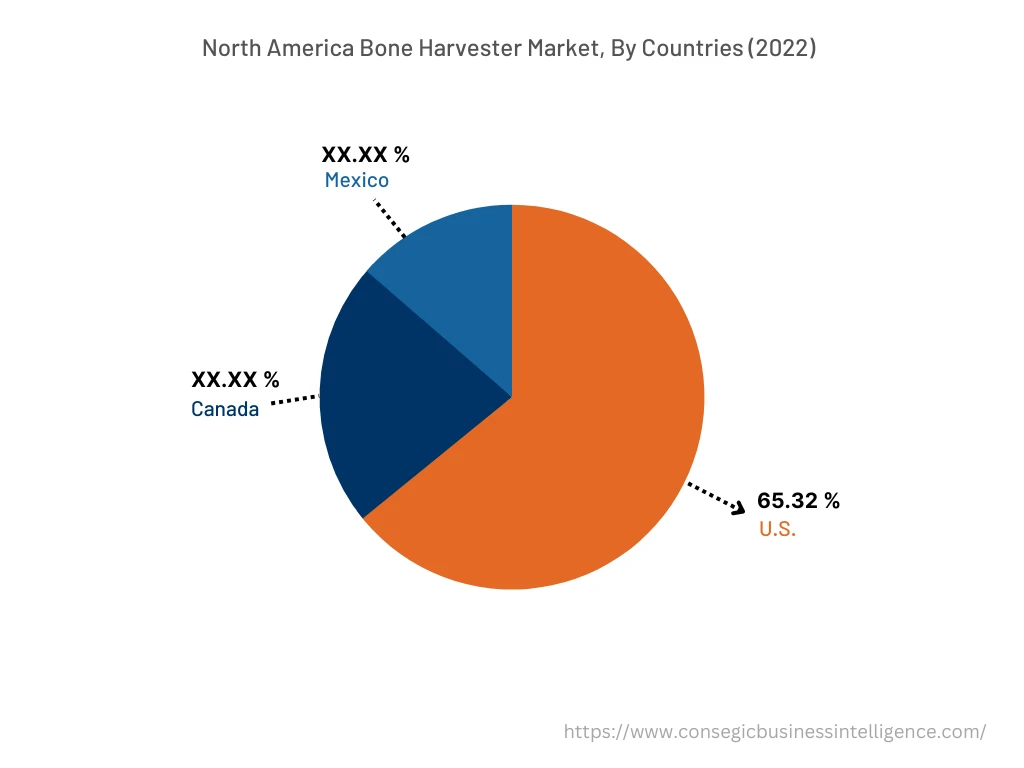
Top Key Players & Market Share Insights :
The global bone harvester market is highly competitive, with several large players and numerous small and mid-range enterprises. Companies operating in bone harvester industry have strong research and development capabilities and a strong presence in the market through their extensive product portfolios and distribution networks. The bone harvester market analysis indicated that the market is characterized by intense competition, with companies in the industry focusing on expanding their product offerings and increasing their market share through mergers, acquisitions, and partnerships. The key players in the market include-
- Acumed LLC
- Globus Medical
- Paragon 28, Inc.
- Conmed Corporation
- Paradigm Biodevices Inc.
- Zimmer Biomet
- DePuy Synthes (Johnson & Johnson)
- Arthrex, Inc.
- Avitus Orthopaedics
- Trinity Orthopedics
- Wright Medical Group N.V.
- Stryker
- Biogennix, LLC.
Recent Industry Developments :
- In May 2022, Biogennix, LLC, an advanced bone regeneration technology company, announced the launch of the DirectCell Advanced Bone Grafting System. The system is aimed to provide surgeons and hospitals with comprehensive bone graft solutions in a single product.
- In August 2021, DePuy Synthes, the Orthopaedics Company of Johnson & Johnson, announced the launch of new products and technology solutions for new standards of care for modern-day orthopedics during the American Academy of Orthopaedic Surgeons (AAOS) annual meeting.
Key Questions Answered in the Report
What was the market size of the bone harvester market in 2022? +
In 2022, the market size of bone harvester was USD 18,593.69 million.
What will be the potential market valuation for the bone harvester market by 2030? +
In 2030, the market size of bone harvester will be expected to reach USD 27,657.78 million.
What are the key factors driving the growth of the bone harvester market? +
Rising cases of bone fracture and the increasing prevalence of bone disorders are the key factors driving the growth of the bone harvester market.
What is the dominating segment in the bone harvester market, by method? +
In 2022, the bone marrow aspirate segment accounted for the highest market share of 43.50% in the overall bone harvester market.
Based on current market trends and future predictions, which geographical region will have the fastest impact on the bone harvester market's growth in the coming years? +
Asia Pacific is expected to be the fastest-growing region in the market during the forecast period.
